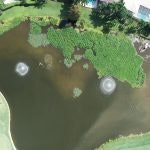Aquatic Plants

December 6, 2019 By Katie Roundtree
Northern Palm Beach County Improvement District manages over 2,000 acres of preserves and approximately 370 water bodies in its 128 square mile jurisdiction. Each of these areas is unique and has different kinds of aquatic plants growing within it depending on factors such as depth, size and location. Aquatic plants that can be seen with the naked eye are generally called aquatic macrophytes, to differentiate them from the much smaller plants called algae. Aquatic plants are further classified into three categories depending upon where they grow.
Aquatic plants can be submersed, meaning that they grow under the water, either rooted to the bottom sediments or free floating. They come in all shapes and sizes and occur in virtually all local waterbodies. Environmental factors such as light, water clarity, temperature, pH, nutrient availability and sediment stability affect where submersed plants will grow. These plants are professionally managed and, as with many native and non-native plant populations, can grow to nuisance levels if not maintained properly. Excess nutrient levels from fertilizers and yard waste can further increase the growth of these plants to a nuisance level. Some advantages of submersed plants are to provide habitats for fish and wildlife, increase water clarity, filter nutrients and increase or decrease dissolved oxygen levels.
Emersed plants are plants that are rooted in water-saturated soils or submersed sediment near the water’s edge, with their leaves and stems exposed. They can grow from the water’s edge to about three to ten feet from the shore. This area is typically called the littoral zone and may be composed of a shoreline or wetlands. In our area, some of these areas were man made to attract wildlife to the littoral zone in order to compensate for recently developed areas. In periods of low water, debris from dying emersed plants is a significant factor. Accumulated plant debris can eventually result in the lake becoming shallower, or even transitioning into a swamp or marsh. Some advantages of emersed plants include providing bank stabilization to reduce shoreline erosion, maintaining habitat for fish and wildlife and providing food (seeds and leaves) for birds.
Finally, free floating plants are not anchored to any soil or sediment; they get their nutrients from the water alone. Floating-leaved plants typically are rooted in the sediments and have leaves that float on the water’s surface. Native water lilies and duckweed are examples of these kinds of plants. Floating and floating-leaved plants occur in many Florida waterbodies. Rooted floating-leaved plants can grow completely across shallow waterbodies. The roots of floating-leaved plants provide a stable surface for successful fish spawning. Some advantages of free floating or floating-leaved plants include providing bank stabilization to reduce shoreline erosion and maintaining habitat for fish and wildlife. However, if periods of low water are followed by a rapid rise in water level, the roots of dead floating-leaved plants can float to the surface, block access, and hinder navigation. Non-native water hyacinth and water lettuce may completely cover the surface of a waterbody and cause major problems for fish and wildlife habitat, recreation, navigation, and flood control. Floating and floating-leaved plants are not generally considered a human health concern, but they provide breeding habitat for mosquitoes. (Source: University of Florida IFAS)
